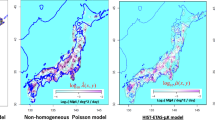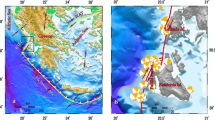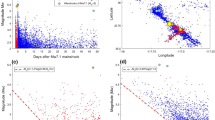Abstract
A stochastic triggering (epidemic) model incorporating short-term clustering was fitted to the instrumental earthquake catalog of Italy for event with local magnitudes 2.6 and greater to optimize its ability to retrospectively forecast 33 target events of magnitude 5.0 and greater that occurred in the period 1990–2006. To obtain an unbiased evaluation of the information value of the model, forecasts of each event use parameter values obtained from data up to the end of the year preceding the target event. The results of the test are given in terms of the probability gain of the epidemic-type aftershock sequence (ETAS) model relative to a time-invariant Poisson model for each of the 33 target events. These probability gains range from 0.93 to 32000, with ten of the target events yielding a probability gain of at least 10. As the forecasting capability of the ETAS model is based on seismic activity recorded prior to the target earthquakes, the highest probability gains are associated with the occurrence of secondary mainshocks during seismic sequences. However, in nine of these cases, the largest mainshock of the sequence was marked by a probability gain larger than 50, having been preceded by previous smaller magnitude earthquakes. The overall evaluation of the performance of the epidemic model has been carried out by means of four popular statistical criteria: the relative operating characteristic diagram, the R score, the probability gain, and the log-likelihood ratio. These tests confirm the superior performance of the method with respect to a spatially varying, time-invariant Poisson model. Nevertheless, this method is characterized by a high false alarm rate, which would make its application in real circumstances problematic.
Similar content being viewed by others
References
Aki K (1981) A probabilistic synthesis of precursory phenomena. In: Simpson DW, Richards PG (eds) Earthquake prediction. Am. Geophys. Union, Washington, pp 556–574
Baiesi M (2006) Scaling and precursor motifs in earthquake networks. Physica A 360(2):534–542
Catalli F, Cocco M, Console R, Chiaraluce L (2008) Modeling seismicity rate changes during the 1997 Umbria–Marche sequence (central Italy) through a rate-and state-dependent model. J Geophys Res 113:B11301. doi:10.1029/2007JB005356
Chen C-C, Rundle JB, Li H-C, Holliday JR, Nanjo KZ, Turcotte DL, Tiampo KF (2006) From tornados to earthquakes: forecast verification for binary events applied to the 1999 Chi-Chi, Taiwan, Earthquake. Terr Atmos Ovean Sci 17(3):503–516
Chiarabba C, Jovane L, Di Stefano R (2005) A new view of Italian seismicity using 20 years of instrumental recordings. Tectonophysics 395(3–4):251–268. http://legacy.ingv.it/CSI. doi:10.1016/j.tecto.2004.09.013
Console R (2001) Testing earthquake forecast hypotheses. Tectonophysics 338:261–268. doi:10.1016/S0040-1951(01)00081-6
Console R, Murru M (2001) A simple and testable model for earthquake clustering. J Geophys Res 106:8699–8711. doi:10.1029/2000JB900269
Console R, Murru M, Lombardi AM (2003) Refining earthquake clustering models. J Geophys Res 108:2468. doi:10.1029/2002JB002130
Console R, Murru M, Catalli F (2006a) Physical and stochastic models of earthquake clustering. Tectonophysics 417:141–153. doi:10.1016/j.tecto.2005.05.052
Console R, Rhoades DA, Murru M, Evison FF, Papadimitriou EE, Karakostas VG (2006b) Comparative performance of time-invariant, long-range and short-range forecasting models on the earthquake catalogue of Greece. J Geophys Res 111:B09304. doi:10.1029/2005JB004113
Console R, Murru M, Catalli F, Falcone G (2007) Real time forecasts through an earthquake clustering model constrained by the rate-and-state constitutive law: comparison with a purely stochastic ETAS model. Seismol Res Lett 78:49–56. doi:10.1785/gssrl.78.1.49
Dieterich JH (1994) A constitutive law for rate of earthquake production and its application to earthquake clustering. J Geophys Res 99(18):2601–2618. doi:10.1029/93JB02581
Felzer KR, Becker TW, Abercrombie RE, Ekstrom G, Rice JR (2002) Triggering of the 1999 Mw 7.1 Hector Mine earthquake by aftershocks of the 1992 Mw 7.3 Landers earthquake. J Geophys Res 107(B9):2190. doi:10.1029/2001JB000911.2002
Frankel A (1995) Mapping seismic hazard in the central and eastern United States. Seismol Res Lett 66:8–21
Gerstenberger MC, Wiemer S, Jones LM, Reasenberg PA (2005) Real-time forecasts of tomorrow’s earthquakes in California. Nature 435:328–331. doi:10.1038/nature03622
Gomberg J, Beeler NM, Blanpied ML (2000) On rate-state and Coulomb failure models. J Geophys Res 105(14):7857–7872. doi:10.1029/1999JB900438
Harris RA, Simpson RW (1998) Suppression of large earthquakes by stress shadows: a comparison of Coulomb and rate-and-state failure. J Geophys Res 103:24439–24451. doi:10.1029/98JB00793
Hauksson E, Cocco M, Console R, Wiemer S (2007) Advancing the frontiers of earthquake science. EOS 88(30):302
Helmestetter A, Shaw BE (2006) Relation between stress heterogeneity and aftershock rate in the rate-and-state model. J Geophys Res 111(B07304). doi:101029/2005JB004077
Helmstetter A, Sornette D (2002) Subcritical and supercritical regimes in epidemic models o earthquake aftershocks. J Geophys Res 107(B10):2237. doi:10.1029/2001JB001580
Helmstetter A, Sornette D (2003) Predictability in the epidemic-type aftershock sequence model of interacting triggered seismicity. J Geophys Res 108(B10):2482. doi:10.1029/2003JB002485
Holliday JR, Nanjo KZ, Tiampo KF, Rundle JB, Turcotte DL (2005) Earthquake forecasting and its verification. Nonlinear Process Geophys 12:965–977
Imoto M (2007) Information gain of a model based on multidisciplinary observations with correlations. J Geophys Res 112:B05306. doi:10.1029/2006JB004662
INGV (2007) Italian seismic bulletin. Istituto Nazionale di Geofisica e Vulcanologia. http://legacy.ingv.it/~roma/reti/rms/bollettino/index.php
Jordan TH (2006) Earthquake probability, brick by brick. Seismol Res Lett 77(1):3–6. doi:10.1785/gssrl.77.1.3
Kagan YY (1991) Likelihood analysis of earthquake catalogues. Geophys J Int 106:135–148. doi:10.1111/j.1365-246X.1991.tb04607.x
Kagan YY (2002) Aftershock zone scaling. Bull Seismol Soc Am 92(2):641–655. doi:10.1785/0120010172
Kagan YY (2007) On earthquake predictability measurement: information score and error diagram. Pure Appl Geophys 164:1947–1962. doi:10.1007/s00024-007-0260-1
Kagan YY, Jackson DD (1995) New seismic gap hypothesis, Five years later. J Geophys Res 100:3943–3959. doi:10.1029/94JB03014
Kilb D, Gomberg J, Bodin P (2002) Aftershocks triggering by complete Coulomb stress changes. J Geophys Res 107. doi:10.1029/2001JB0002002
King GCP, Cocco M (2001) Fault interaction by elastic stress changes: new clues from earthquake sequences. Adv Geophys 44:1–39
King GCP, Stein R, Lin J (1994) Static stress change and the triggering of earthquakes. Bull Seismol Soc Am 84:935–953
Kossobokov VG (2006) Testing earthquake prediction methods: the West Pacific short-term forecast of earthquakes with magnitude MwHRV ≥ 5.8. Tectonophysics 413(1–2):25–31. doi:10.1016/j.tecto.2005.10.006
Ma L, Zhuang J (2001) Relative Quiescence within the Jiashi Swarm in Xinjiang, China: an application of the ETAS point process model. J Appl Probab 38:213–221 (Probability, Statistics and Seismology)
Marsan D (2006) Can coseismic stress variability suppress seismicity shadows? Insights from a rate-and-state friction model. J Geophys Res 111(B10):6305. doi:10.1029/2005JB004060
Matthews MM, Reasenberg PP (1988) Statistical methods for investigating quiescence and other temporal seismicity patterns. Pure Appl Geophys 126:2–4, 357–372. doi:10.1007/BF00879003
McGuire JJ, Boettcher MS, Jordan TH (2005) Foreshock sequences and short-term earthquake predictability on East Pacific Rise transform faults. Nature 434(7032):457–461, Correction-Nature 435(7041):528
Murru M, Console R, Falcone G (2008) Real-time earthquake forecasting in Italy. Tectonophysics. doi:10.1016/j.tecto.2008.090.010
Nostro C, Chiaraluce L, Cocco M, Baumont D, Scotti O (2005) Coulomb stress changes caused by repeated normal faulting earthquakes during the 1997 Umbria–Marche (central Italy) seismic sequence. J Geophys Res 110(B05S20). doi:10.1029/2004JB003386
Ogata Y (1983) Estimation of the parameters in the modified Omori formula for aftershock frequencies by the maximum likelihood procedure. J Phys Earth 31:115–124
Ogata Y (1998) Space–time point-process models for earthquake occurrences. Ann Inst Stat Math 50(2):379–402. doi:10.1023/A:1003403601725
Ogata Y (2001) Increased probability of large earthquakes near aftershock regions with relative quiescence. J Geophys Res 106(B5):8729–8744. doi:10.1029/2000JB900400
Ogata Y (2004a) Space-time model for regional seismicity and detection of crustal stress changes. J Geophys Res 109(B3):B03308. doi:10.1029/2003JB002621
Ogata Y (2004b) Seismicity quiescence and activation in western Japan associated with the 1944 and 1946 great earthquakes near the Nankai trough. J Geophys Res 109(B4):B04305. doi:10.1029/2003JB002634
Ogata Y (2005) Synchronous seismicity changes in and around the northern Japan preceding the 2003 Tokachi-oki earthquake of M8.0. J Geophys Res 110(B5):B08305. doi:10.1029/2004JB003323
Ogata Y (2006a) Monitoring of anomaly in the aftershock sequence of the 2005 earthquake of M7.0 off coast of the western Fukuoka, Japan, by the ETAS model. Geoph Res Lett 33(1):L01303. doi:10.1029/2005GL024405
Ogata Y (2006b) Seismicity anomaly scenario prior to the major recurrent earthquakes off the east coast of Miyagi Prefecture, northern Japan. Tectonophysics 424:291–306. doi:10.1016/j.tecto.2006.03.038
Ogata Y (2007) Seismicity and geodetic anomalies in a wide area preceding the Niigata-Ken-Chuetsu earthquake of 23 October 2004, central Japan. J Geophys Res 112:B10301. doi:10.1029/2006JB004697
Ogata Y, Katsura K (1993) Analysis of temporal and spatial heterogeneity of magnitude frequency distribution inferred from earthquake catalogues. Geophys J Int 113:727–738. doi:10.1111/j.1365-246X.1993.tb04663.x
Ogata Y, Katsura K (2006) Immediate and updated forecasting of aftershock hazard. Geophys Res Lett 33(10):L10305. doi:10.1029/2006GL025888
Ogata Y, Zhuang J (2006) Space-time ETAS models and an improved extension. Tectonophysics 413:13–23. doi:10.1016/j.tecto.2005.10.016
Ogata Y, Jones LM, Toda S (2003) When and where the aftershock activity was depressed: contrasting decay patterns of the proximate large earthquakes in southern California. J Geophys Res 108(B6):2318. doi:10.1029/2002JB002009 (1-12)
Parsons T (2004) Recalculated probability of M ≥ 7 earthquakes beneath the Sea of Marmara, Turkey. J Geophys Res 109:B05304. doi:10.129/2003JB002667
Parsons T, Dreger DS (2000) Static-stress impact of the 1992 landers earthquake sequence on nucleation andslip at the site of the 1999 M = 7.1 Hector Mine earthquake, southern California. Geophys Res Lett 27:1949–1952. doi:10.1029/1999GL011272
Rhoades DA, Evison FF (1989) On the reliability of precursors. Ph Earth Plann Int 58:137–140. doi:10.1016/0031-9201(89)90049-6
Rydelek PA, Sacks IS (1989) Testing the completeness of earthquake catalogs and the hypothesis of self-similarity. Nature 337:251–253. doi:10.1038/337251a0
Saichev A, Sornette D (2006) Renormalization of branching models of triggered seismicity from total to observable seismicity. Eur Phys J B 51:443–459. doi:10.1140/epjb/e2006-00242-6
Shi Y, Bolt B (1982) The standard error of the magnitude frequency b value. Bull Seismol Soc Am 72:1677–1687
Shi Y, Liu J, Zhang G (2001) An evaluation of Chinese annual earthquake predictions, 1990–1998. J Appl Probab 38A:222–231. doi:10.1239/jap/1085496604
Steacy S, Nalbant S, McCloskey J, Nostro C, Scotti O, Beaumont D (2005) Onto what planes should Coulomb stress perturbations be resolved? J Geophys Res 110(B05S15). doi:10.1029/2004JB003356
Stein RS, Barka AA, Dieterich JH (1997) Progressive failure on the North Anatolian fault since 1939 by earthquake stress triggering. Geophys J Int 128:594–604. doi:10.1111/j.1365-246X.1997.tb05321.x
S2 project (2005–2007) Evaluation of seismogenic potential and probability of large earthquakes in Italy supported for the years 2005–2007 by the Italian Department for Civil Protection (DPC) and the Istituto Nazionale di Geofisica e Vulcanologia (INGV)
Toda S, Stein RS (2003) Toggling of seismicity by the 1997 Kagoshima earthquake couplet: a demonstration of time-dependent stress transfer. J Geophys Res 109(B12, 2567). doi:10.1029/2003JB002527
Toda S, Stein RS, Richards-Dinger K, Bozkurt SB (2005) Forecasting the evolution of seismicity in southern California: animations built ion earthquakes stress transfer. J Geophys Res 110:B05S16. doi:10.1029/2004JB003415
Wiemer S (2001) A software package to analyze seismicity: ZMAP. Seismol Res Lett 72:373–382
Wiemer S, Benoit J (1996) Mapping the b-value anomaly at 100 km depth in Alaska and New Zealand subduction zones. Geophys Res Lett 23:1557–1560. doi:10.1029/96GL01233
Wiemer S, Wyss M (2000) Minimum magnitude of completeness in earthquake catalogs: examples from Alaska, the Western United States, and Japan. Bull Seism Soc Am 90:859–869
Zechar JD, Jordan TH (2007) Testing alarm-based earthquake predictions. Geophys J Int. doi:10.1111/j.1365-246X.2007.03676.x
Zhuang J, Ogata Y, Vere-Jones D (2004) Analyzing earthquake clustering features by using stochastic reconstruction. J Geophys Res 109(B5):B05301. doi:10.1029/2003JB002879
Zhuang J, Chang C, Ogata Y, Chen Y (2005) A study on the background and clustering seismicity in the Taiwan region by using point process models. J Geophys Res 110(B5):B05S18. doi:10.1029/2004JB003157
Author information
Authors and Affiliations
Corresponding author
Rights and permissions
About this article
Cite this article
Console, R., Murru, M. & Falcone, G. Probability gains of an epidemic-type aftershock sequence model in retrospective forecasting of M ≥ 5 earthquakes in Italy. J Seismol 14, 9–26 (2010). https://doi.org/10.1007/s10950-009-9161-3
Received:
Accepted:
Published:
Issue Date:
DOI: https://doi.org/10.1007/s10950-009-9161-3




